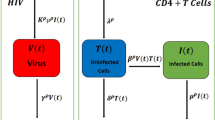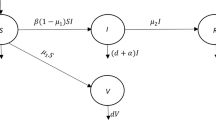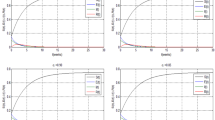Abstract
The purpose of this paper is to study a fractional mathematical model on diphtheria disease, considering the parameters of natural immunity, treatment, and vaccination. This model includes five compartments, namely, the susceptible, exposed, infected, quarantined, and recovered sub population. All compartments involve the memory effect and long-rate interactions that is modeled by a Caputo fractional derivative. This paper starts with the study of some analytical results. We first present the preliminary concepts of fractional calculus. The well-posedness of our fractional model is proved based on the boundedness, non-negativity, existence, and uniqueness. The existence of local, and global stability are also studied based on the Magniton’s theorem and the appropriate Lyapunov function. We further apply the predictor–corrector scheme to establish the numerical simulations. The validation of our fractional model is based on the real data by using the least square technique. We also present the comparison results of root mean square error for varying fractional order \(\alpha =1\), \(\alpha =0.95\), \(\alpha =0.9\), \(\alpha =0.85\), and \(\alpha =0.8\).










Similar content being viewed by others
Data availability statement
This study uses secondary data from the Ministry of Health of the Republic of Indonesia, which is published online. The reference used as secondary data information for the purposes of this study refers to Sariadji (2017).
References
Ahmed E, El-Sayed AMA, El-Saka HAA (2006) On some Routh-Hurwitz conditions for fractional order differential equations and their applications in Lorenz, Rössler, Chua and Chen systems. Phys Lett Sect A Gen Atom Solid State Phys 358:1–4
Almeida R, Pooseh S, Torres DFM (2015) Computational methods in the fractional calculus of variations. Imperial College Press, London, p xii+266
Alshamrani M, Zedan H, Abu-Nawas M (2017) Lie group method and fractional differential equations. J Nonlinear Sci Appl 10:4175–4180
Bhadauria AS, Devi S, Gupta N (2022) Modelling and analysis of a SEIQR model on COVID-19 pandemic with delay. Model Earth Syst Environ 8:3201–3214
Choi SK, Kang B, Koo N (2014) Stability for caputo fractional differential systems. Abstr Appl Anal 2014:631419
Diethelm K, Ford NJ, Freed AD (2002) A predictor–corrector approach for the numerical solution of fractional differential equations. Nonlinear Dyn 29:3–22
Garrappa R (2011) Predictor–corrector PECE method for fractional differential equations. MATLAB Central File Exchange, File ID: 32918
Garrappa R (2010) On linear stability of predictor–corrector algorithms for fractional differential equations. Int J Comput Math 87(10):2281–2290
Gazizov R, Kasatkin A (2013) Construction of exact solutions for fractional order differential equations by the invariant subspace method. Comput Math Appl 66:576–584
George AJ, Chakrabarti A (1995) The Adomian method applied to some extraordinary differential equations. Appl Math Lett 8(3):91–97
Gerberry DJ, Milner FA (2009) An SEIQR model for childhood diseases. J Math Biol 59:535–561
Hamdan NI, Kilicman A (2018) A fractional order SIR epidemic model for dengue transmission. Chaos Solitons Fract 114:55–62
Hamdan NI, Kilicman A (2019) Analysis of the fractional order dengue transmission model: a case study in Malaysia. Adv Differ Equ 114:3
Huo J, Zhao H, Zhu L (2015) The effect of vaccines on backward bifurcation in a fractional order HIV model. Nonlinear Anal Real World Appl 26:289–305
Hussain T, Ozair M, Ali F, Rehman SU, Assiri TA, Mahmoud EE (2021) Sensitivity analysis and optimal control of COVID-19 dynamics based on SEIQR model. Results Phys 22:103956
Izzati N, Andriani A (2020) Optimal control of diphtheria epidemic model with prevention and treatment. J Phys Conf Ser 1663:012042
Izzati N, Andriani A (2021) Dynamical analysis of diphtheria epidemic model with natural immunity rate on exposed individuals. J Phys Conf Ser 1869:012117
Li Y, Chen YQ, Podlubny I (2010) Stability of fractional-order nonlinear dynamic systems: Lyapunov direct method and generalized Mittag-Lefer stability. Comput Math Appl 59:1810–1821
Li HL, Zhang L, Hu C, Jiang YL, Teng Z (2017) Dynamical analysis of a fractional-order predator-prey model incorporating a prey refuge. J Appl Math Comput 54:435–449
Matignon D (1996) Stability results on fractional differential equations to control processing. In: Proceedings of the 1996 IMACS multiconference on computational engineering in systems and application multiconference, 9–12 July, Lille, France, vol 2, pp 963–968
Moustafa M, Mohd MH, Ismail AI, Abdullah FA (2018) Dynamical analysis of a fractional-order Rosenzweig-MacArthur model incorporating a prey refuge. Chaos Solitons Fract 109:1–13
Moustafa M, Mohd MH, Ismail AI, Abdullah FA (2019) Stage structure and refuge effects in the dynamical analysis of a fractional order Rosenzweig-MacArthur prey–predator model. Prog Fract Differ Appl 5:49–64
Odibat ZM, Shawagfeh NT (2007) Generalized Taylor’s formula. Appl Math Comput 186:286–293
Owolabi KM, Atangana A (2017) Spatiotemporal dynamics of fractional predator–prey system with stage structure for the predator. Int J Appl Comput Math 3:903–924
Petras I (2011) Fractional-order nonlinear systems: modeling analysis and simulation. Springer, Bei**g, China
Podlubny I (1999) Fractional differential equations: an introduction to fractional derivatives, fractional differential equations, to methods of their solution and some of their applications. Academic Press, California, USA
Prabakaran R, Jemimah S, Rawat P, Sharma D, Gromiha MM (2021) A novel hybrid SEIQR model incorporating the effect of quarantine and lockdown regulations for COVID-19. Sci Rep 11(1):24073–24079
Rahimi I, Gandomi AH, Asteris PG, Chen F (2021) Analysis and prediction of covid-19 using SIR, SEIQR and machine learning models: Australia, Italy and UK cases. Information 12(3):109
Saleh W, Kilicman A (2019) Note on the fractional Mittag-Lefer functions by applying the modified Riemann-Liouville derivatives. Bol Soc Parana Mat
Sariadji K (2017) Indonesia’s diphtheria outbreak: problems in vaccination and antibiotics efficacy. The Conversation December 17
Shang Y (2012) A Lie algebra approach to susceptible-infected-susceptible epidemics. Electron J Differ Equ 2012:1–7
Shang Y (2013) Lie algebra method for solving biological population model. J Theor Appl Phys 7:67
Shang Y (2017) Lie algebraic discussion for affinity based information diffusion in social networks. Open Phys 15:83
Vargas-De-Leon C (2015) Volterra-type Lyapunov functions for fractional-order epidemic systems. Commun Nonlinear Sci Numer Simul 24:75–85
Youssef H, Alghamdi N, Ezzat MA, El-Bary AA, Shawky AM (2021) Study on the SEIQR model and applying the epidemiological rates of COVID-19 epidemic spread in Saudi Arabia. Infect Dis Model 6:678–692
Youssef HM, Alghamdi N, Ezzat MA, El-Bary AA, Shawky AM (2022) A proposed modified SEIQR epidemic model to analyze the COVID-19 spreading in Saudi Arabia. Alex Eng J 61(3):2456–2470
Acknowledgements
The authors received financial support for the research under contract number 121/UN3.1.17/PT/2022 by the Faculty of Advanced Technology and Multidiscipline, Universitas Airlangga, Indonesia. The authors would also like to thank the reviewers for their valuable comments and suggestions which helped to improve the paper.
Funding
Mohammad Ghani received financial support for the research under contract number 121/UN3.1.17/PT/2022 by the Faculty of Advanced Technology and Multidiscipline, Universitas Airlangga, Indonesia.
Author information
Authors and Affiliations
Contributions
MG: formal analysis, investigation, methodology, software, writing—original draft, writing—review and editing. IQU: formal analysis, investigation, methodology, software, writing—original draft, writing—review and editing. AWT: conceptualization, formal analysis, investigation, writing—original draft, writing—review and editing. MA: conceptualization, formal analysis, investigation, writing—original draft, writing—review and editing.
Corresponding author
Ethics declarations
Conflict of interest
None of the authors of this paper has a financial or personal relationship with other people or organizations that could inappropriately influence or bias the content of the paper. It is to specifically state that “No Competing interests are at stake and there is No Conflict of Interest” with other people or organizations that could inappropriately influence or bias the content of the paper.
Additional information
Publisher's Note
Springer Nature remains neutral with regard to jurisdictional claims in published maps and institutional affiliations.
Rights and permissions
Springer Nature or its licensor (e.g. a society or other partner) holds exclusive rights to this article under a publishing agreement with the author(s) or other rightsholder(s); author self-archiving of the accepted manuscript version of this article is solely governed by the terms of such publishing agreement and applicable law.
About this article
Cite this article
Ghani, M., Utami, I.Q., Triyayuda, F.W. et al. A fractional SEIQR model on diphtheria disease. Model. Earth Syst. Environ. 9, 2199–2219 (2023). https://doi.org/10.1007/s40808-022-01615-z
Received:
Accepted:
Published:
Issue Date:
DOI: https://doi.org/10.1007/s40808-022-01615-z




